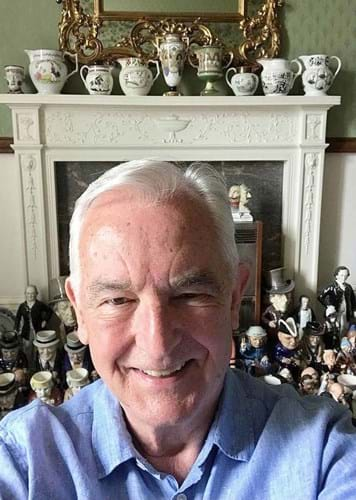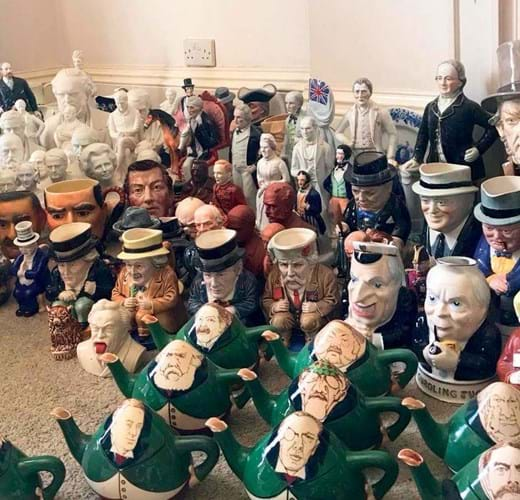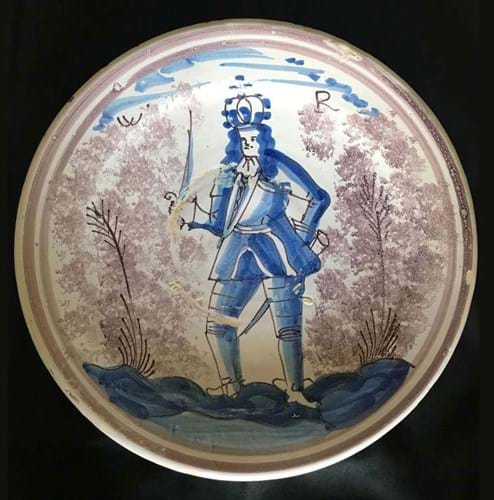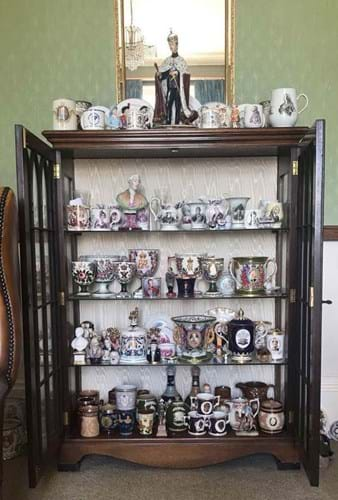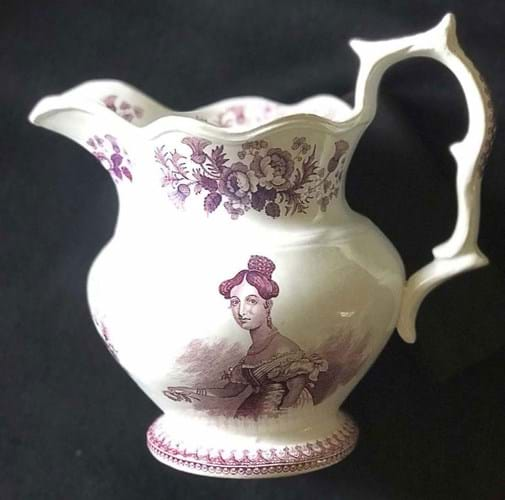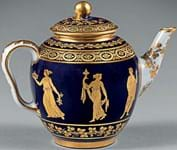Denzil Lush is a retired solicitor and a former judge (master) in the court of protection dealing with mental capacity. He is now chairman of brain injury association Headway. He lives in Exeter and collects political and royal commemorative ceramics.
ATG: how and when did you get the collecting bug?
Denzil Lush: I have always been interested in history and as a boy I could recite the names and dates of the kings and queens of England from William the Conqueror onwards, and still can. This may sound a little precocious but children tended to learn things by rote in those days.
In 1960, when I was nine, my grandma was about to chuck out a 1911 coronation beaker, which had been presented to her as a schoolgirl in Portsmouth. I said to her: “You can’t throw that away. It’s an antique.” And she replied: “Well, if you feel so strongly about it, you can have it.” Not only did she give me the beaker but she also gave me the 1937 coronation mug that been presented to my mother, when she was a schoolgirl in Portsmouth.
I then started collecting them and was often given a coronation or jubilee mug, jug or plate as birthday and Christmas presents. My parents kindly let me use a cupboard on the landing, where my collection was displayed on the shelves.
I read history at University College London from 1970-74 and, although I did not have much in the way of income at that time, I would occasionally visit Britannia, a stall run by Rita Smythe in Grays Antiques Market just off Oxford Street. One day I bought from her a polychrome porcelain bust of WE Gladstone, made in Austria, and subsequently purchased a Lancaster’s toby jug of Neville Chamberlain. I got immense pleasure from both of these figures and from then on my collection tended to be more political than royal.
What I particularly enjoy about the political items is that many of them are polychrome images of human beings. The better ones manage to portray their character, strengths, weaknesses, and eccentricities. Because they are glazed, they gleam, which somehow gives them vitality. Sometimes they’re flattering, and sometimes they’re satirical.
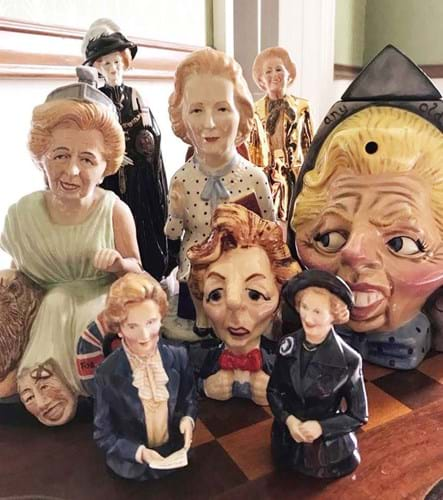
Denzil Lush’s Margaret Thatcher collection. He has a fondness for Thatcher as he saw her sign documents in her bold blue fountain pen and he now has a signed copy of her book.
Margaret Thatcher (in respect of whom I have 36 pieces – more than any other prime minister except Winston Churchill at 47) is a wonderful example of this. A few items portray her as beatific, almost as if she were the Blessed Virgin Mary, and others depict her as totally manic.
In the run-up to the General Election in May 2015, fifty items from my collection, depicting most of the prime ministers from William Pitt the Younger to David Cameron, were displayed for three months in the Royal Albert Memorial Museum at Exeter.
How large is your collection?
I haven’t counted them but there are well over 500 pieces. Approximately 300 are political – by which I mean they commemorate not simply individual politicians but also legislation, such as the abolition of slavery, the Reform Bill, the repeal of the Corn Laws, and including three pieces relating to the Tichborne Trial in 1871-72, which for many years was the longest trial in English legal history.
The remainder consists mainly of royal commemoratives (including about a dozen foreign monarchs and a similar number of US presidents), as well as commemorative wares from military to sporting events. I even have a mug designed by Grayson Perry featuring Sir Chris Whitty, the chief medical adviser to the government during the Covid pandemic.
Where do you display it all?
I outgrew my china cabinet years ago. It has 90 items inside and 20 on top. There are numerous commemorative pieces on the top of my kitchen cabinets, and a vast army of them is slowly advancing towards me across the carpet in my living room.
I make no apologies for this and to some extent I agree with the following quotation from Bruce Chatwin’s novel, Utz (1988). Utz was a fictional Czech collector of Meissen, whose obsession with porcelain (porzellankrankheit) was preventing him from defecting to the West: “An object in a museum case”, he wrote, “must suffer the de-natured existence of an animal in the zoo. In any museum the object dies – of suffocation and the public gaze – whereas private ownership confers on the owner the right and the need to touch. As a young child will reach out to handle the thing it names, so the passionate collector, his eye in harmony with his hand, restores to the object the life-giving touch of its maker.”
Among many other items in my kitchen there are 15 one-pint mugs, designed for Wedgwood, mainly by Richard Guyatt, but also two by Eric Ravilious for the intended crowning of Edward VIII and the actual coronation of George VI in 1937, and a Ravilious-inspired mug produced posthumously for the coronation in 1953. These are arranged in a pyramid formation, an idea I copied from John Pym, who used to display the Wedgwood mugs in this manner in his shop window, Hope & Glory, in Kensington Church Street. I always thought the presentation was eye-catching.
I am sorry to say that there are some items in my collection which are wrapped in bubble wrap and stored in boxes. I really should bring them out and put them on show.
What is the most you have ever spent on an item for your collection?
£7000 for an English Delft charger depicting King William III, elaborately crowned and standing in a full set of armour, which I purchased from the late Jonathan Horne. I have two English Delft plates and a Dutch Delft dish from about 1690 which commemorate both William and Mary; and two Dutch Delft royal lobed dishes, the smaller one of William, and the larger one of Mary. I also have a London Delft blue and white plate with a half-length portrait of Queen Anne, which I bought at Christie’s in the sale of Syd Levethan’s Longridge Collection in 2011.
I also have a few items of modern Delft. The factories in the Netherlands have been consistently good at commemorating not only their own royal events, but world events.
What elements do you look for when considering a purchase?
(i) Aesthetics. Only a few weeks ago I went into Mark Sullivan’s shop in Cecil Court. I saw an ivory-coloured tankard commemorating the golden jubilee of the Emperor Franz Joseph I of Austria-Hungary in 1898. It has a hand-painted portrait of him within a very rich gilt frame. I think it’s absolutely beautiful and instantly fell for it.
(ii) Interesting. A lot of commemorative pieces are really dull and banal, and I prefer items that are interesting. A few months ago I decided that I ought to buy a Liz Truss mug. I looked online and eventually acquired one with a fairly attractive portrait (rather than a photo) of her delivering her resignation speech outside the door of Number 10 Downing Street. The caption below the portrait is Dear oh dear, which were the first words King Charles said to her when she turned up for her weekly audience within sometime in October last year. It made me laugh.
(iii) Rarity. Rarity is an interesting concept and to some extent it can be deceptive. EBay and the internet generally have given us a clearer idea of what may be out there in the big wide world.
(iv) Price. I always ask dealers “what’s the best you price can do?” I think it is par for the course and every dealer expects to be asked that question. Beyond that I don’t haggle. I find it distasteful.
(v) Investment value. This is not an important issue as far as I’m concerned. I’m a single man and I’m not amassing a collection for the benefit of my heirs. However, I think it would be foolish to fork out a lot of money for something that you know will be less valuable in years to come.
(vi) Condition. Beggars can’t be choosers. It’s unlikely that you will find a piece of English delftware that hasn’t been professionally restored. I don’t know any professional restorers personally and wouldn’t consider buying a badly damaged item (even if it were rare or important) because, unrestored, I would always notice or subconsciously be aware of the flaws.
(vii) Sentimental. This involves a personal involvement with a particular individual, time, or place. I have a Read & Clementson jug commemorating the coronation of Queen Victoria in 1838. I bought it in 1968, when we were on a family holiday in the Lake District, and it is a souvenir – a constant reminder of that occasion. I missed out on buying a jug commemorating the death of Prince Albert when we were in Tenby on holiday the following year and it remained in my thoughts for years and years. Eventually, about 30 years later I bought such a jug in London, but I always associate it with Tenby.
Having considered all these elements (sometimes within a split second), there are three reactions: -
(1) I must have it;
(2) I’ll think about it; or
(3) I’m not interested.
With regard to the second reaction, I do think about it quite seriously and assess the extent to which I would feel disappointed if that item were no longer available when I next looked for it online or in a shop. As a younger man, I often felt a deep sense of regret when I missed out on a particular piece. Somehow, it matters less to me now.
What other items in your collection spark sentimental memories?
On my bathroom wall is a Delft plate commemorating the birth of Prince Johan Friso of the Netherlands on September 25, 1968. Tragically, in 2012 he was buried in an avalanche while skiing in Austria and died 18 months later, never having regained consciousness. I was involved professionally in a transaction regarding his property and affairs in England. It was an immense privilege to be able to assist his family in distressing circumstances, and I acquired the plate as a perpetual reminder of him and them.
Where do you find items to buy?
The process has changed considerably over the six decades in which I have been collecting commemoratives. Initially, it involved visiting antiques shops in various towns up and down the country, and very occasionally attending an auction. My first auction was in Plymouth in 1966, when I bought a King George III in memoriam spill vase for £10.
During the 1970s and 80s I tended to visit the London dealers, Rita Smythe in Grays Antiques Market and Hope and Glory, and John & Jennifer May’s in Kensington Church Street. May’s was wonderful, but out of my league pricewise when I was a young man. I did, however, buy from them a copy of their book, and a mug they commissioned for Princess Anne’s wedding in 1973, which is a brilliant example of Pop-Art design by the graphic artist Clifford Richards.
Until 1996, when I was in my mid-forties, I didn’t have much disposable income, but from then onwards I ventured into Jonathan Horne’s, also in Kensington Church Street, where I purchased a number of the earlier pieces. He was an expert in early English pottery.
In the early years of this century I became aware of antiques fairs, and began to look on eBay. I don’t like online auctions because I am wary of participating with people who are far more ‘savvy’ than me and know how to work the system to their advantage. I generally prefer the ‘Buy Now’ option.
For about 20 years, until the pandemic brought such proceedings to an abrupt end, I tended to buy mainly at the Antiques for Everyone exhibitions at the NEC from specialist dealers such as Peter and Sue Rees, trading as Commemorative Ceramics; the late Roger de Ville; and the late Brian Carruthers, trading as Bac to Basics Antiques.
I always visit Mark Sullivan’s shop in Cecil Court whenever I’m in London, and I regularly look to see what’s available online.
For King Charles III’s coronation, apart from a couple of shop purchases (a Guyatt-inspired Wedgwood Mug in Selfridges, and a tankard from the Buckingham Palace shop), I acquired three pieces directly from the potteries themselves: Ewenny, Moorcroft, and Wemyss Ware.
Is there an item you are still looking for?
Yes, there are several. They tend to be pieces required to complete a sub-collection. For example. I have eight Foley Intarsio Teapots of statesmen, produced in c.1900. There are three more that have eluded me so far and I wouldn’t mind one or two of the taller coffee pots of some of these statesmen produced by the same potter.
I don’t have any items commemorating King George I – the only British monarch since 1689 missing from my collection. Maybe one day I shall obtain one. And there are a few prime ministers – in respect of whom ceramics were produced – who aren’t represented in my collection. Lord Melbourne is a case in point.
How would you classify your buying/ collecting habit?
I wouldn’t describe it as either compulsive or obsessive. I reckon I could quite easily desist and stop buying further items – for a while, at least.
I feel a strong sense of affinity with Henry Willett (1823-1905), a brewer who collected ceramics and donated his collection to Brighton Museum. His collection is much larger than mine (2000 pieces) but there are similarities. I can sit in my armchair and survey three centuries of British history in a single glance.
Occasionally, I may act strategically. Last year I decided that my collection was weak in terms of pieces relating to Prince William, so I acquired a few more which appealed to me; the same happened a few months later with the Prime Minister David Lloyd George. These were all online purchases.
Have you sold anything from your collection or plan to?
No. I have no plans to sell any at present. However, I am conscious that, as I grow older, I may have to downsize.
My predecessor as Master of the Court of Protection, Biddy Macfarlane (1930-2019), had an extensive collection of Victorian tiles, which, like my own collection, was scattered all over her house. I remember distinctly my first visit to see her in a nursing home in 2015. I was taken aback – almost traumatised – when I realised that all her worldly possessions (a few books, a few pictures, and a few knick knacks) were now contained in this single, not very large, bedroom, and that she had disposed of the tile collection she had dearly loved and taken years to assemble.
By contrast, a year before I saw Biddy in the nursing home, I visited the Kirkcaldy Museum and Art Gallery. The owner of many of these paintings was Michael Portillo’s grandfather, John Waldegrave Blyth (1873-1962), a linen manufacturer. He had lent many of them to the art gallery while he was still alive. Every Monday afternoon he would visit the gallery and spend a couple of hours sitting there, just looking at his pictures, recalling how and when he acquired them, and simply appreciating their beauty.
I may eventually dispose of some of the more mundane pieces, probably by donating them to a charity shop, rather than selling them.
What advice would you give a young collector?
I recommend that you obtain a few books on the subject to give you some idea of what’s out there, how common it is, and an approximate price guide. I have more than 20 books on various potteries and themes but, even though they are quite ancient, the ones I tend to consult most frequently are: John and Jennifer May, Commemorative Pottery 1780-1900 (Heinemann, 1972); Eric Knowles, Miller’s Royal Memorabilia (Miller’s, 1994); and Douglas Hall, The Book of Churchilliana (New Cavendish Books, 2002).
Choose what appeals to you and is going to give you genuine pleasure for the rest of your life. If you have the means to purchase something and are likely to regret not acquiring it, then go ahead and buy it.
Do you collect anything else?
Yes. When I was a child my favourite toy was a Victory plywood jigsaw puzzle of the Industrial Life of England and Wales. Each county was cut as a separate piece and it had tiny pictures depicting the different industries that took place there. From that I acquired an interest in places, which resulted in three separate collections:
(1) Shell Guides. I have about 50 of the Faber & Faber guides and 40 volumes of Arthur Mee’s The King’s England.
(2) Map postcards of towns, counties and regions in Great Britain and Ireland. I have about 400.
(3) Visits to football grounds. On August Bank Holiday 1985 I became aware of the existence of ‘The 92 Club’. To become a member, you have to attend a first team fixture at the home grounds of all 92 clubs in what was then the Football League and is now the EFL and Premier League. I finally made it 32 years later on August Bank Holiday 2017, having attended over 130 matches to qualify (the number grows due to club moves/demotions/promotions). At about the same time, I also completed the same achievement in respect of the 42 professional football clubs in Scotland.
To be frank, I am far more interested in visiting the place than in watching the football match itself, but the football acts as a catalyst and I usually spent a fair amount of time sightseeing either before or after the game.
This is still an active collection and since the pandemic I have several new grounds to acquire. I intend to do so, as and when I can.


